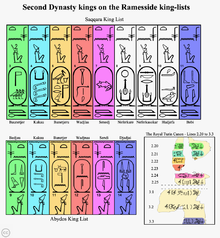
Back 2de Dinastie van Egipte Afrikaans الأسرة المصرية الثانية Arabic اسره مصريه تانيه ARZ Misirdə ikinci padşahlıq dövrü Azerbaijani Втора династия на Древен Египет Bulgarian Eil tierniezh Henegipt Breton Dinastia II d'Egipte Catalan 2. dynastie Czech 2. Dynastie German Δεύτερη δυναστεία Φαραώ της Αιγύπτου Greek
Second Dynasty of Egypt | |||||||||
|---|---|---|---|---|---|---|---|---|---|
| c. 2890 BC–c. 2686 BC | |||||||||
 Statue of Khasekhemwy, Ashmolean Museum | |||||||||
| Capital | Thinis | ||||||||
| Common languages | Egyptian language | ||||||||
| Religion | ancient Egyptian religion | ||||||||
| Government | Absolute monarchy | ||||||||
| Historical era | Bronze Age | ||||||||
• Established | c. 2890 BC | ||||||||
• Disestablished | c. 2686 BC | ||||||||
| |||||||||
| Periods and dynasties of ancient Egypt |
|---|
|
All years are BC |

The Second Dynasty of ancient Egypt (or Dynasty II, c. 2890 – c. 2686 BC[1]) is the latter of the two dynasties of the Egyptian Archaic Period, when the seat of government was centred at Thinis. It is most known for its last ruler, Khasekhemwy, but is otherwise one of the most obscure periods in Egyptian history.
Though archaeological evidence of the time is very scant, contrasting data from the First and Third Dynasties indicates important institutional and economic developments during the Second Dynasty.[2][3]
- ^ Shaw, Ian, ed. (2000). The Oxford History of Ancient Egypt. Oxford University Press. p. 480. ISBN 0-19-815034-2.
- ^ Romer, John (2013) [2012]. "Chapter 18 – The Lost Dynasty". A History of Ancient Egypt. Vol. 1. London, ENG: Penguin Books. pp. 221–222. ISBN 978-1-8-4614377-9.
Whatever else was taking place at the court of the Second Dynasty of kings, it is clear that the fundamental institutions of pharaonic government, its systems of supply, not only survived throughout that century and a half, but flourished to the extent that, when the kings emerge into the light of history again with the pyramid builders of the Third Dynasty, the state on the lower Nile was more efficient than it had ever been: that there was, therefore, strong institutional continuity.
- ^ Bard, Kathryn A. (2002) [2000]. "Chapter 4 – The Emergence of the Egyptian State". In Shaw, Ian (ed.). The Oxford History of Ancient Egypt (paperback) (1st ed.). Oxford: Oxford University Press. p. 85. ISBN 978-0-19-280293-4.
There is much less evidence for the kings of the 2nd Dynasty than those of the 1st Dynasty until the last two reigns (Peribsen and Khasekhemwy). Given what is known about the early Old Kingdom in the 3rd Dynasty, the 2nd Dynasty must have been a time when the economic and political foundations were put in place for the strongly centralized state, which developed with truly vast resources. Such a major transition, however, cannot be demonstrated from the archaeological evidence for the 2nd Dynasty.